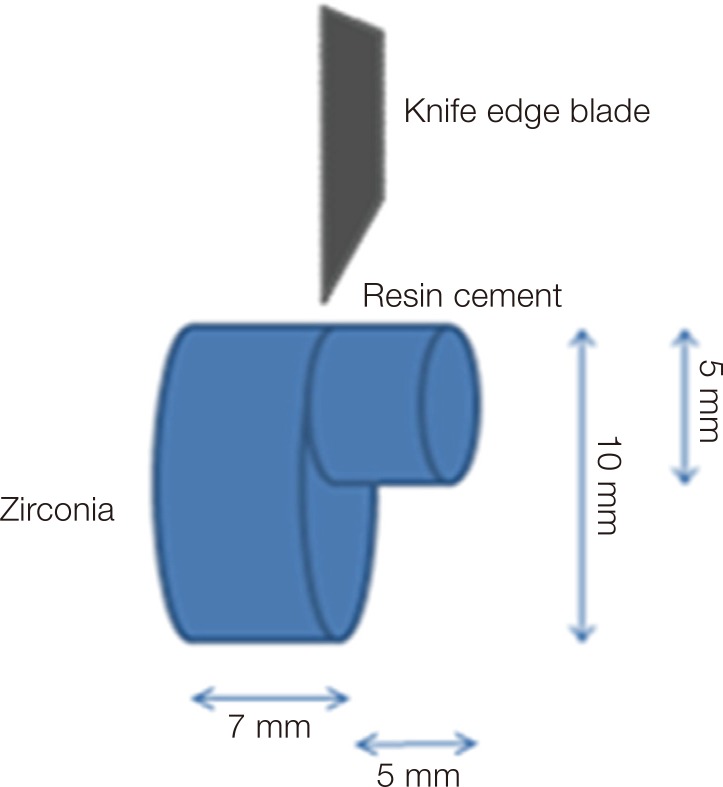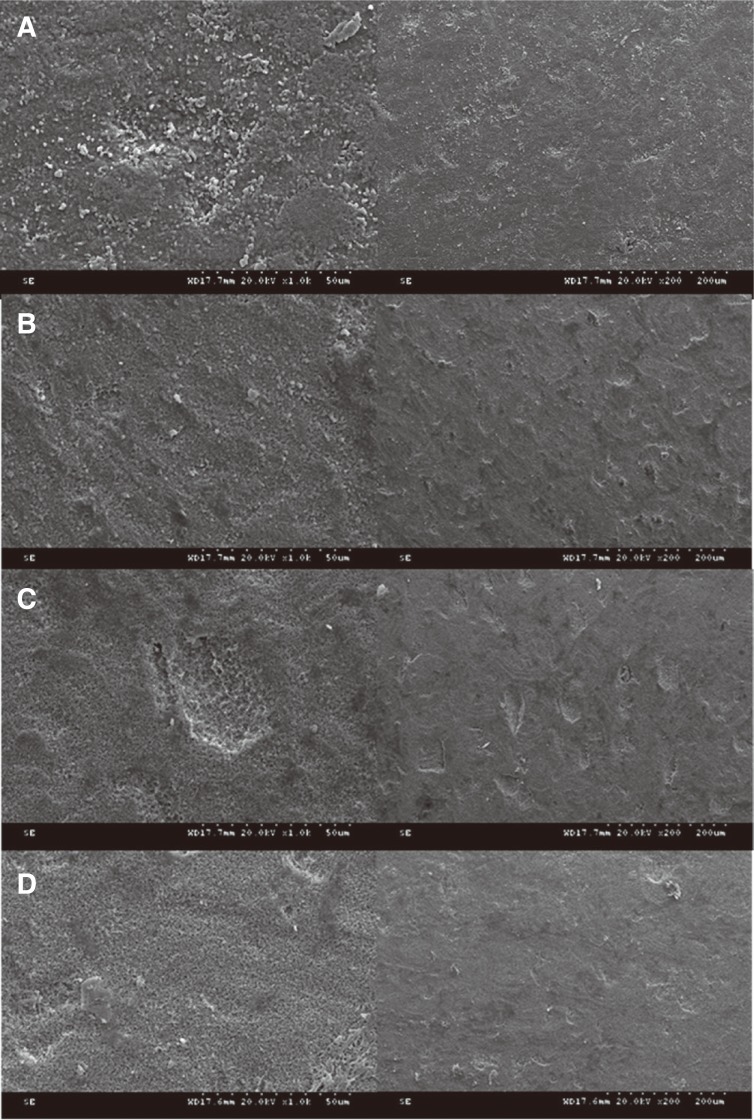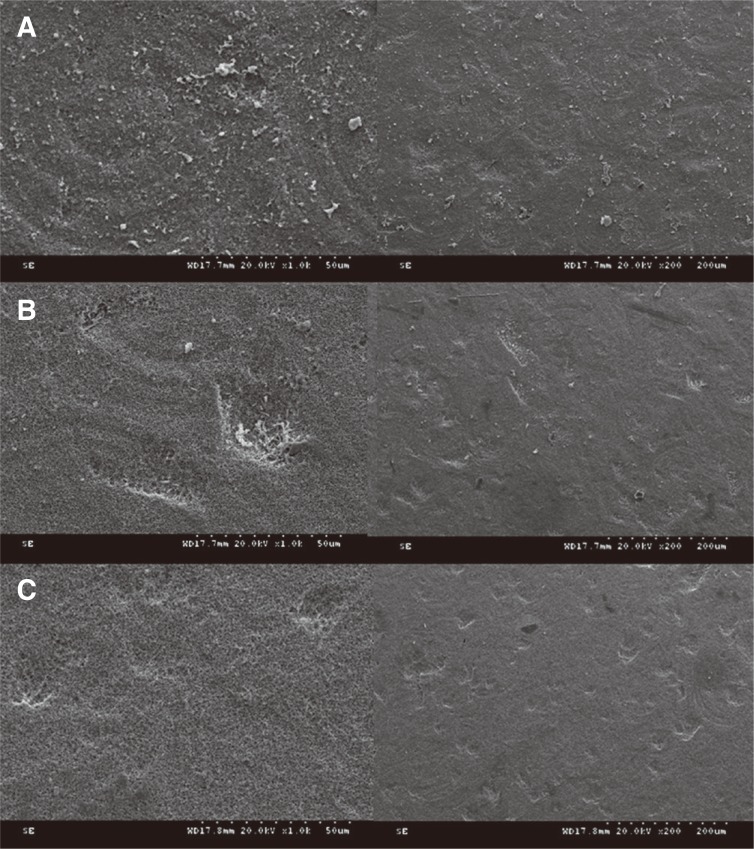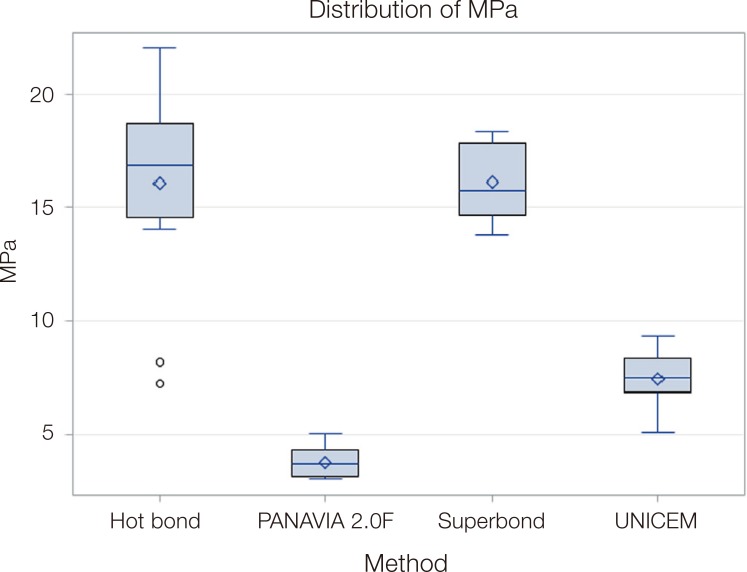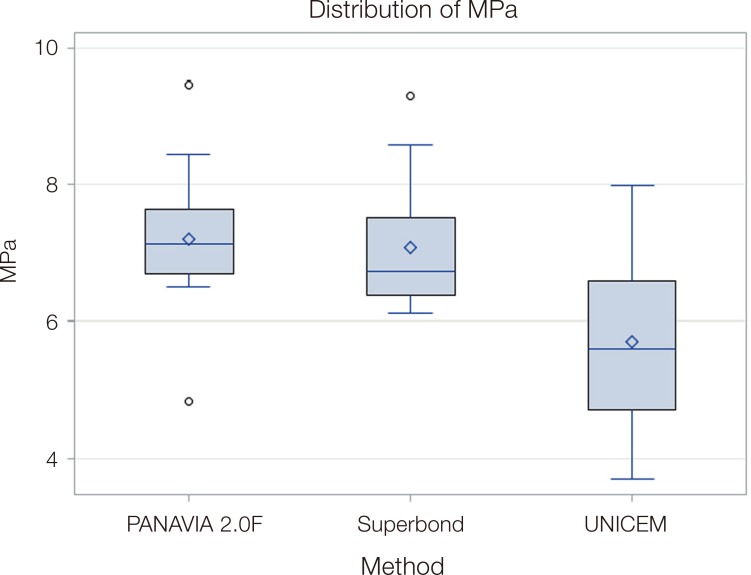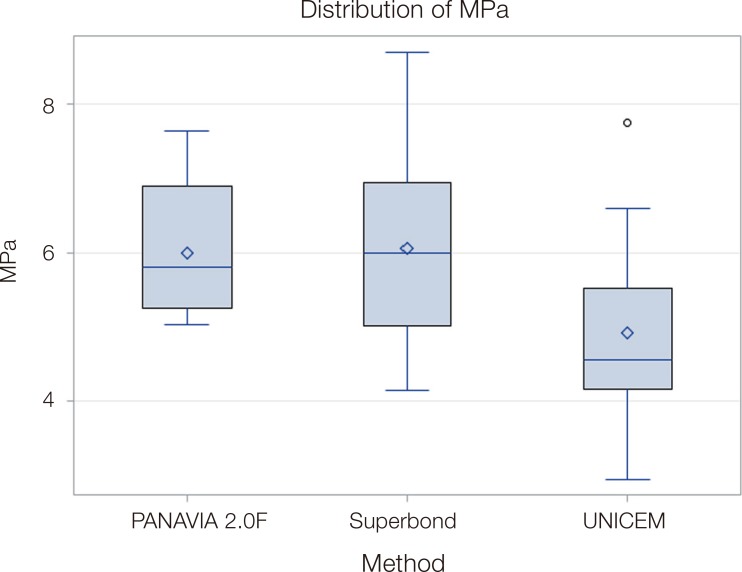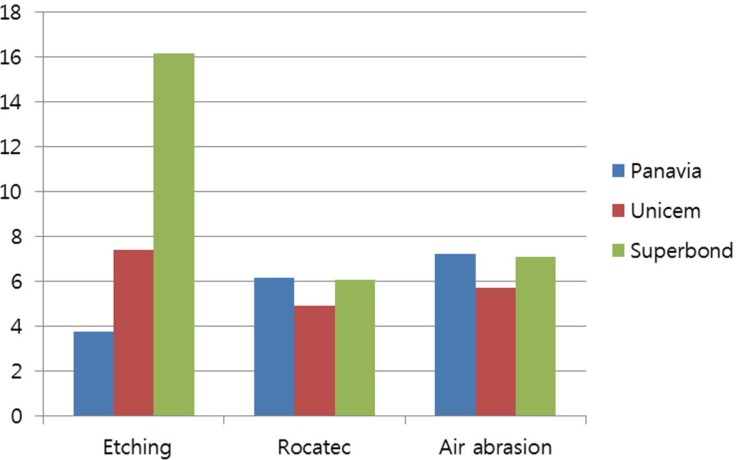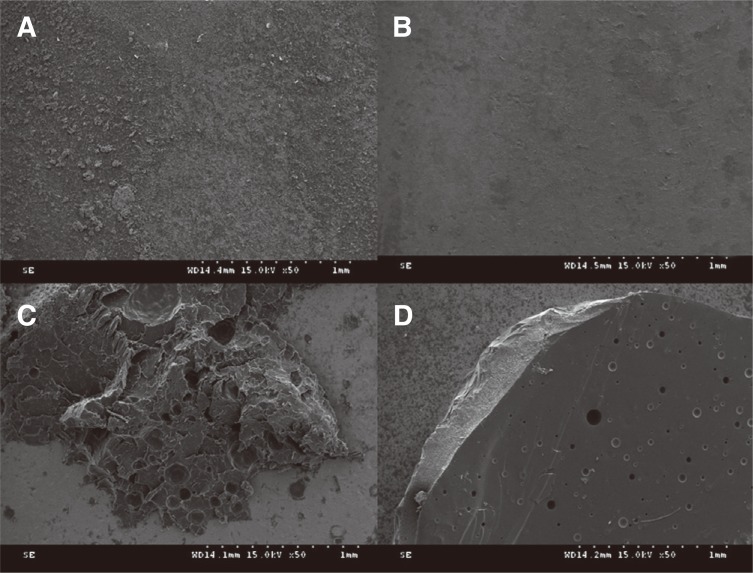Effect of zirconia surface treatment using nitric acid-hydrofluoric acid on the shear bond strengths of resin cements
- Affiliations
-
- 1Department of Prosthodontics, Graduate School, Yonsei University, Seoul, Republic of Korea. KWLEE@yuhs.ac
- KMID: 2376293
- DOI: http://doi.org/10.4047/jap.2017.9.2.77
Abstract
- PURPOSE
The aim of this study was to compare the surface roughness of zirconia when using Zircos E etching system (ZSAT), applying a nitric acid-hydrofluoric acid compound as a pretreatment agent, and also to compare the shear bonding strength according to different resin cements.
MATERIALS AND METHODS
ZSAT, air abrasion, and tribochemical silicacoating were applied on prepared 120 zirconia specimens (10 mm in diameter, 7 mm in height) using CAD/CAM. Each 12 specimens with 4 different resin cements (Panavia F 2.0, Rely X Unicem, Superbond C&B, and Hot bond) were applied to test interfacial bond strength. The statistical analysis was performed using SAS 9.1 (SAS Institute Inc., Cary, NC, USA). The results are as follows: after application of the ZSAT on the zirconia specimens, surface roughness value after 2-hour etching was higher than those after 1- and 3-hour etching on SEM images.
RESULTS
For Superbond C&B and Rely X Unicem, the specimens treated with ZSAT showed higher shear bond strength values than those treated with air abrasion and tribochemical silicacoating system. Regarding the failure mode of interface over cement and zirconia surface, Rely X Unicem and Hot bond showed cohesive failures and Panavia F 2.0 and Superbond C&B showed mixed failures.
CONCLUSION
Zircos E etching system in zirconia restoration could increase its shear bond strength. However, its long term success rate and clinical application should be further evaluated.
Keyword
Figure
Cited by 4 articles
-
Effects of different surface treatments on the shear bond strength of veneering ceramic materials to zirconia
Adil Othman Abdullah, Yu Hui, Xudong Sun, Sarah Pollington, Fenik Kaml Muhammed, Yi Liu
J Adv Prosthodont. 2019;11(1):65-74. doi: 10.4047/jap.2019.11.1.65.The effect of zirconia surface architecturing technique on the zirconia/veneer interfacial bond strength
Soo-Bok Her, Kyoung Hun Kim, Sang Eun Park, Eun-Jin Park
J Adv Prosthodont. 2018;10(4):259-264. doi: 10.4047/jap.2018.10.4.259.Effect of hydrofluoric acid-based etchant at an elevated temperature on the bond strength and surface topography of Y-TZP ceramics
Mi-Kyung Yu, Myung-Jin Lim, Noo-Ri Na, Kwang-Won Lee
Restor Dent Endod. 2019;45(1):e6. doi: 10.5395/rde.2020.45.e6.Effect of hydrofluoric acid-based etchant at an elevated temperature on the bond strength and surface topography of Y-TZP ceramics
Mi-Kyung Yu, Myung-Jin Lim, Noo-Ri Na, Kwang-Won Lee
Restor Dent Endod. 2020;45(1):. doi: 10.5395/rde.2018.45.e6.
Reference
-
1. Koutayas SO, Vagkopoulou T, Pelekanos S, Koidis P, Strub JR. Zirconia in dentistry: part 2. Evidence-based clinical breakthrough. Eur J Esthet Dent. 2009; 4:348–380. PMID: 20111760.2. Reich S, Kappe K, Teschner H, Schmitt J. Clinical fit of four-unit zirconia posterior fixed dental prostheses. Eur J Oral Sci. 2008; 116:579–584. PMID: 19049530.
Article3. Sailer I, Fehér A, Filser F, Gauckler LJ, Lüthy H, Hämmerle CH. Five-year clinical results of zirconia frameworks for posterior fixed partial dentures. Int J Prosthodont. 2007; 20:383–388. PMID: 17695869.4. Kern M, Wegner SM. Bonding to zirconia ceramic: adhesion methods and their durability. Dent Mater. 1998; 14:64–71. PMID: 9972153.
Article5. Qeblawi DM, Muñoz CA, Brewer JD, Monaco EA Jr. The effect of zirconia surface treatment on flexural strength and shear bond strength to a resin cement. J Prosthet Dent. 2010; 103:210–220. PMID: 20362764.
Article6. Thompson JY, Stoner BR, Piascik JR, Smith R. Adhesion/cementation to zirconia and other non-silicate ceramics: where are we now? Dent Mater. 2011; 27:71–82. PMID: 21094526.
Article7. Blatz MB, Sadan A, Martin J, Lang B. In vitro evaluation of shear bond strengths of resin to densely-sintered high-purity zirconium-oxide ceramic after long-term storage and thermal cycling. J Prosthet Dent. 2004; 91:356–362. PMID: 15116037.
Article8. Blatz MB, Chiche G, Holst S, Sadan A. Influence of surface treatment and simulated aging on bond strengths of luting agents to zirconia. Quintessence Int. 2007; 38:745–753. PMID: 17873981.9. Karimipour-Saryazdi M, Sadid-Zadeh R, Givan D, Burgess JO, Ramp LC, Liu PR. Influence of surface treatment of yttrium-stabilized tetragonal zirconium oxides and cement type on crown retention after artificial aging. J Prosthet Dent. 2014; 111:395–403. PMID: 24529652.
Article10. Sriamporn T, Thamrongananskul N, Busabok C, Poolthong S, Uo M, Tagami J. Dental zirconia can be etched by hydrofluoric acid. Dent Mater J. 2014; 33:79–85. PMID: 24492116.
Article11. Vojdani M, Torabi K, Farjood E, Khaledi A. Comparison the Marginal and Internal Fit of Metal Copings Cast from Wax Patterns Fabricated by CAD/CAM and Conventional Wax up Techniques. J Dent (Shiraz). 2013; 14:118–129. PMID: 24724133.12. Martins LM, Lorenzoni FC, Melo AO, Silva LM, Oliveira JL, Oliveira PC, Bonfante G. Internal fit of two all-ceramic systems and metal-ceramic crowns. J Appl Oral Sci. 2012; 20:235–240. PMID: 22666843.
Article13. Subaşı MG, Inan Ö. Influence of surface treatments and resin cement selection on bonding to zirconia. Lasers Med Sci. 2014; 29:19–27. PMID: 23139070.
Article14. Tsukakoshi M, Shinya A, Gomi H, Lassila LV, Vallittu PK, Shinya A. Effects of dental adhesive cement and surface treatment on bond strength and leakage of zirconium oxide ceramics. Dent Mater J. 2008; 27:159–171. PMID: 18540388.
Article15. Xible AA, de Jesus Tavarez RR, de Araujo Cdos R, Bonachela WC. Effect of silica coating and silanization on flexural and composite-resin bond strengths of zirconia posts: An in vitro study. J Prosthet Dent. 2006; 95:224–229. PMID: 16543020.
Article16. Yang B, Barloi A, Kern M. Influence of air-abrasion on zirconia ceramic bonding using an adhesive composite resin. Dent Mater. 2010; 26:44–50. PMID: 19766300.
Article17. Lee HJ, Ryu JJ, Shin SW, Suh KW. Effect of surface treatment methods on the shear bond strength of resin cement ro zirconia ceramic. J Korean Acad Prosthodont. 2007; 45:743–752.18. Lüthy H, Loeffel O, Hammerle CH. Effect of thermocycling on bond strength of luting cements to zirconia ceramic. Dent Mater. 2006; 22:195–200. PMID: 16143382.19. Piwowarczyk A, Lauer HC, Sorensen JA. The shear bond strength between luting cements and zirconia ceramics after two pre-treatments. Oper Dent. 2005; 30:382–388. PMID: 15986960.20. Parsa RZ, Goldstein GR, Barrack GM, LeGeros RZ. An in vitro comparison of tensile bond strengths of noble and base metal alloys to enamel. J Prosthet Dent. 2003; 90:175–183. PMID: 12886211.
Article21. Ozcan M, Nijhuis H, Valandro LF. Effect of various surface conditioning methods on the adhesion of dual-cure resin cement with MDP functional monomer to zirconia after thermal aging. Dent Mater J. 2008; 27:99–104. PMID: 18309618.22. Reddy SM, Vijitha D, Deepak T, Balasubramanian R, Satish A. Evaluation of shear bond strength of zirconia bonded to dentin after various surface treatments of zirconia. J Indian Prosthodont Soc. 2014; 14:38–41. PMID: 24604996.
Article23. Kim JH, Seo JM, Ahn SG, Park JM, Yeob SK. The effect of surface treatment conditioning on shear bond strength between zirconia and dental resin cements. J Korean Acad Prosthodont. 2013; 51:73–80.
Article
- Full Text Links
- Actions
-
Cited
- CITED
-
- Close
- Share
- Similar articles
-
- Shear bond strength of indirect composite material to monolithic zirconia
- Effects of hydrofluoric acid concentration and etching time on the shear bond strength between lithium disilicate ceramic and resin cement
- Shear bond strength of orthodontic bonding resins to porcelain; an in vitro study
- Physical properties of different self-adhesive resin cements and their shear bond strength on lithium disilicate ceramic and dentin
- Bond strength of resin cements to zirconia ceramic

